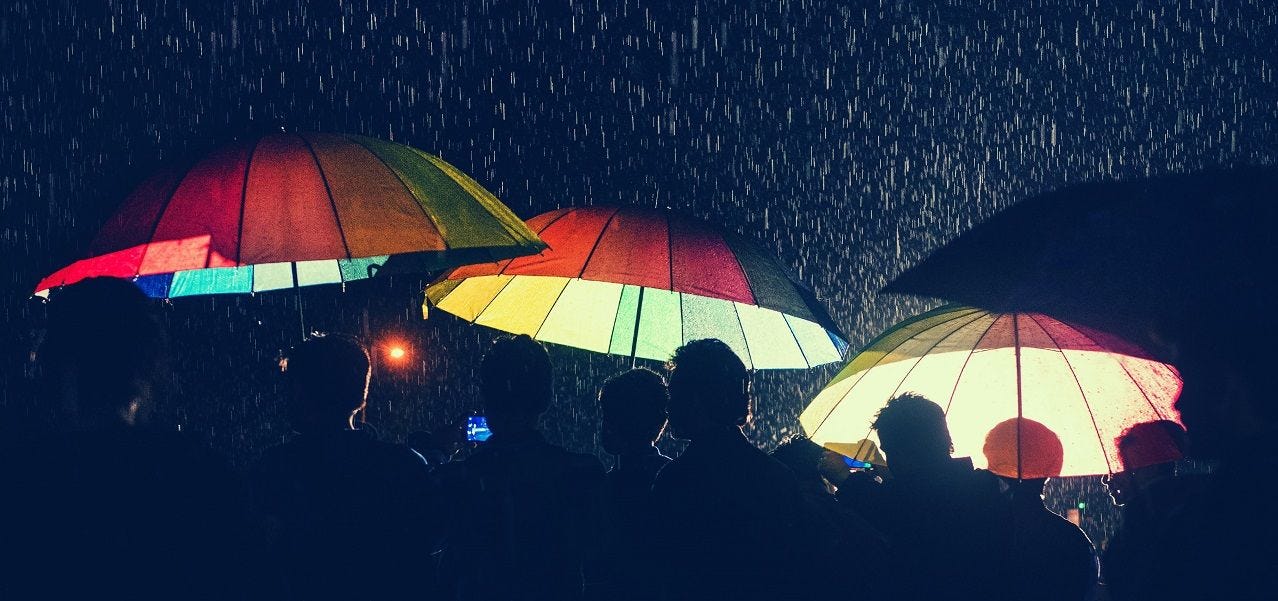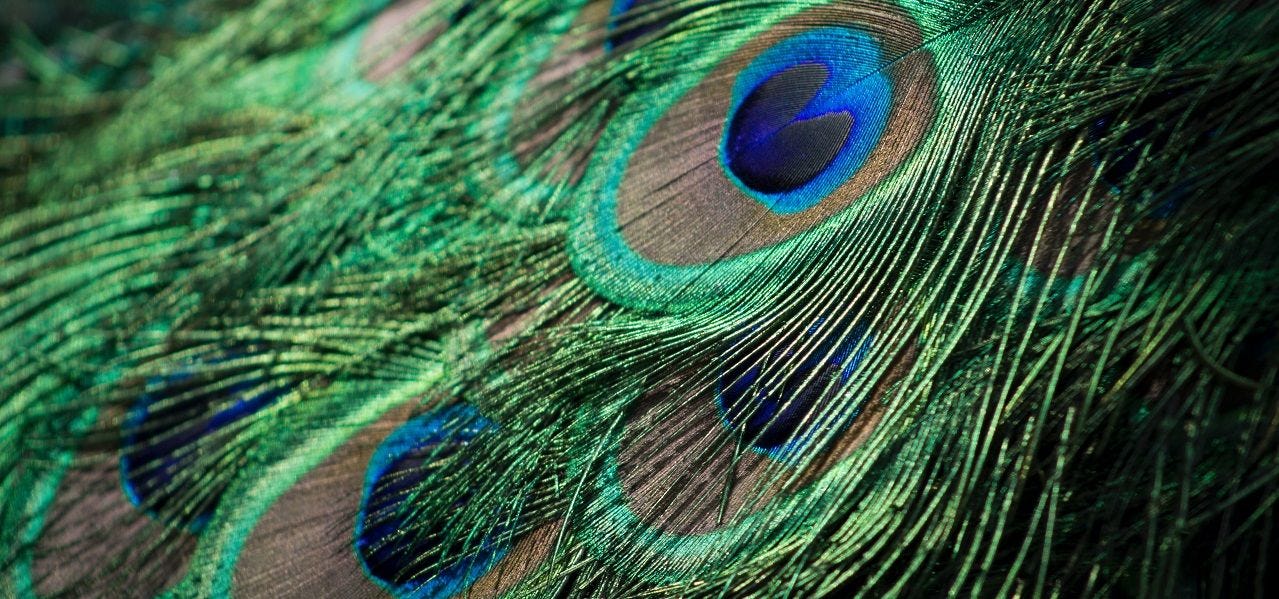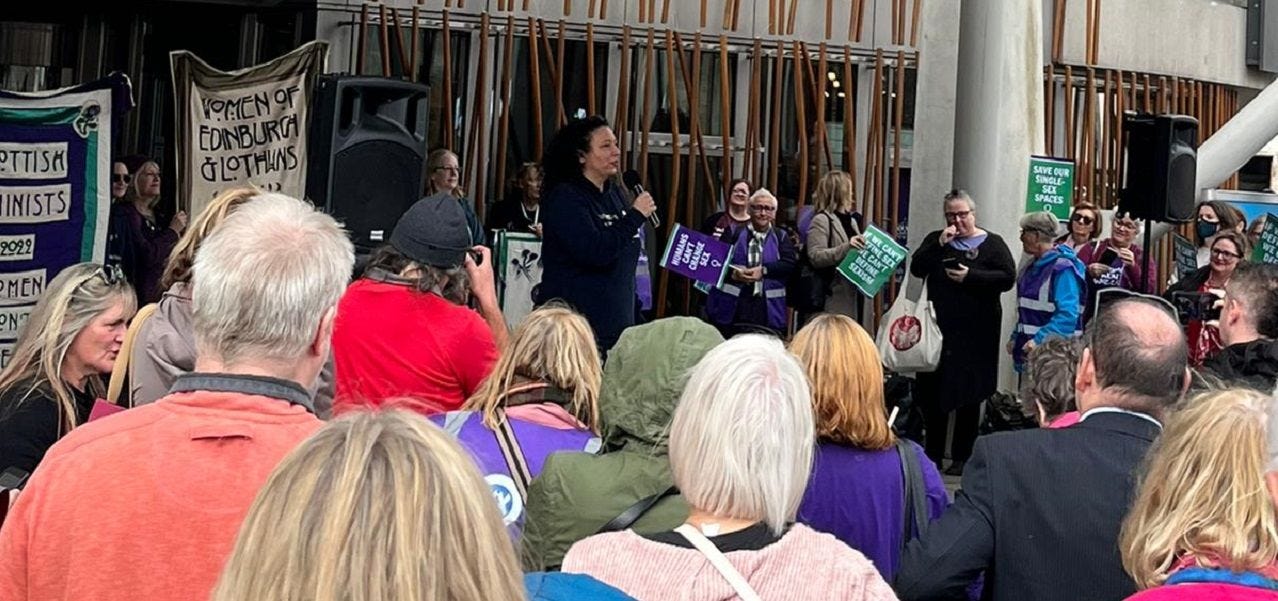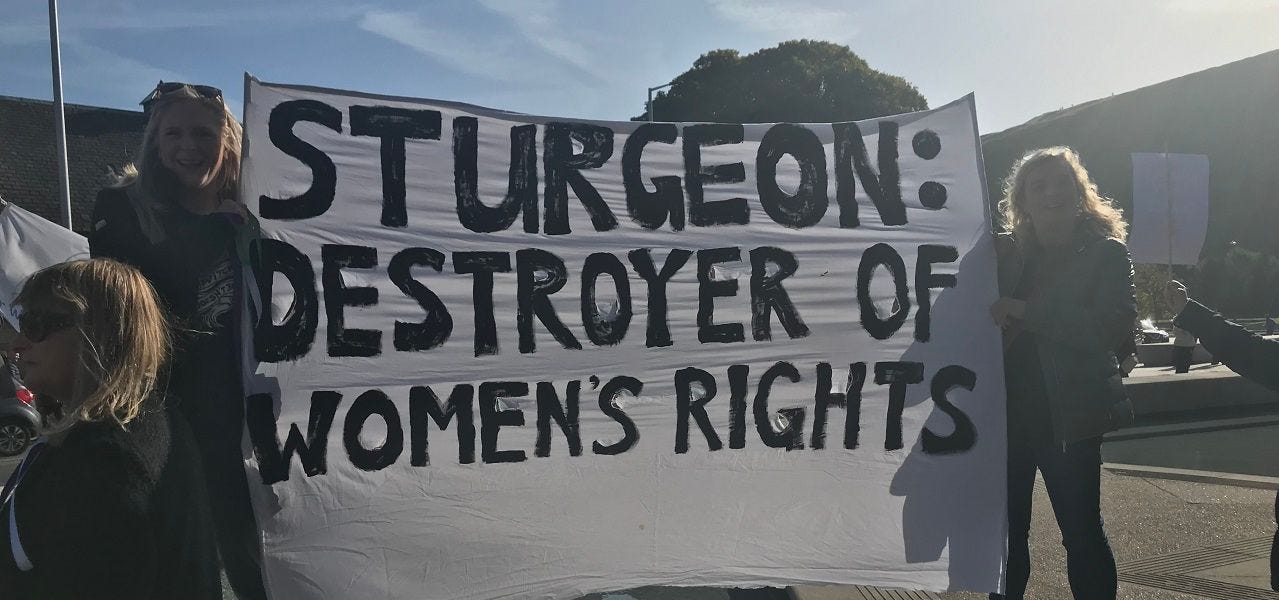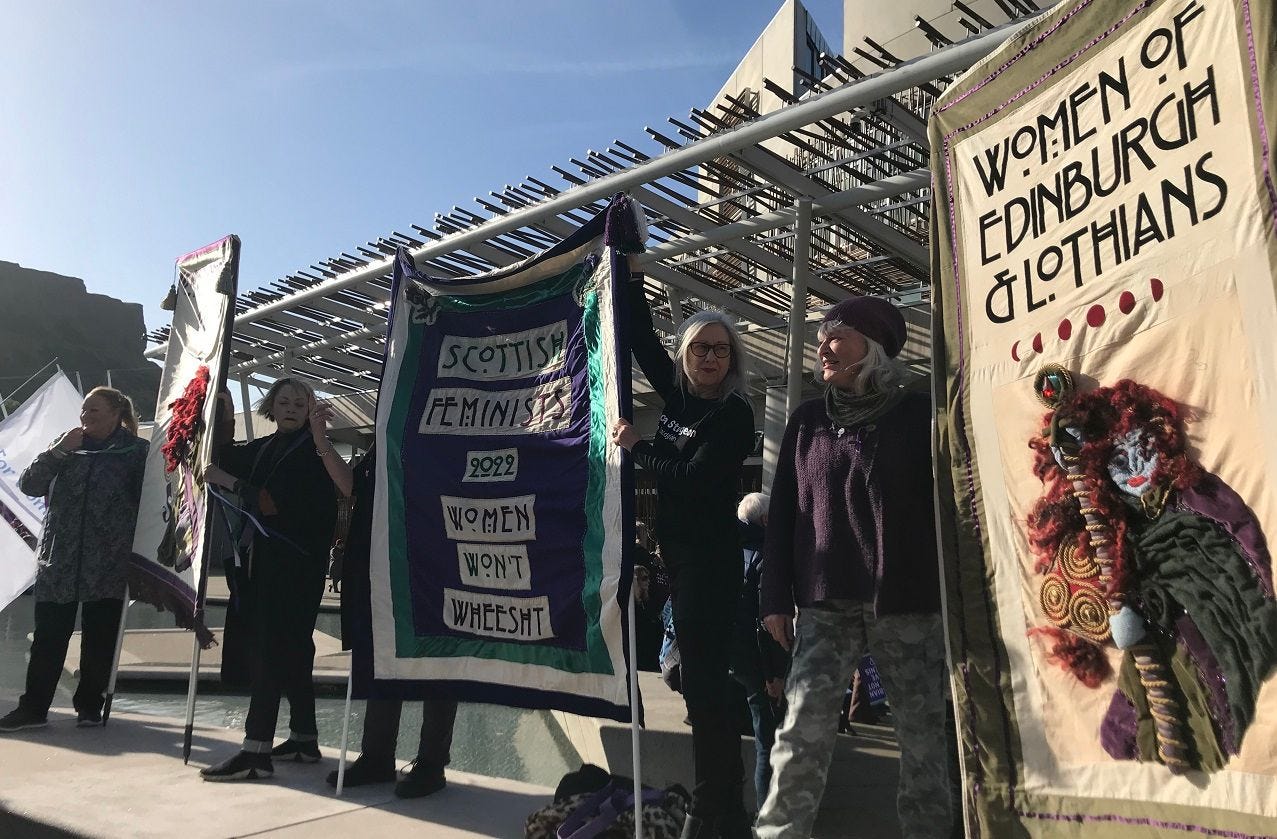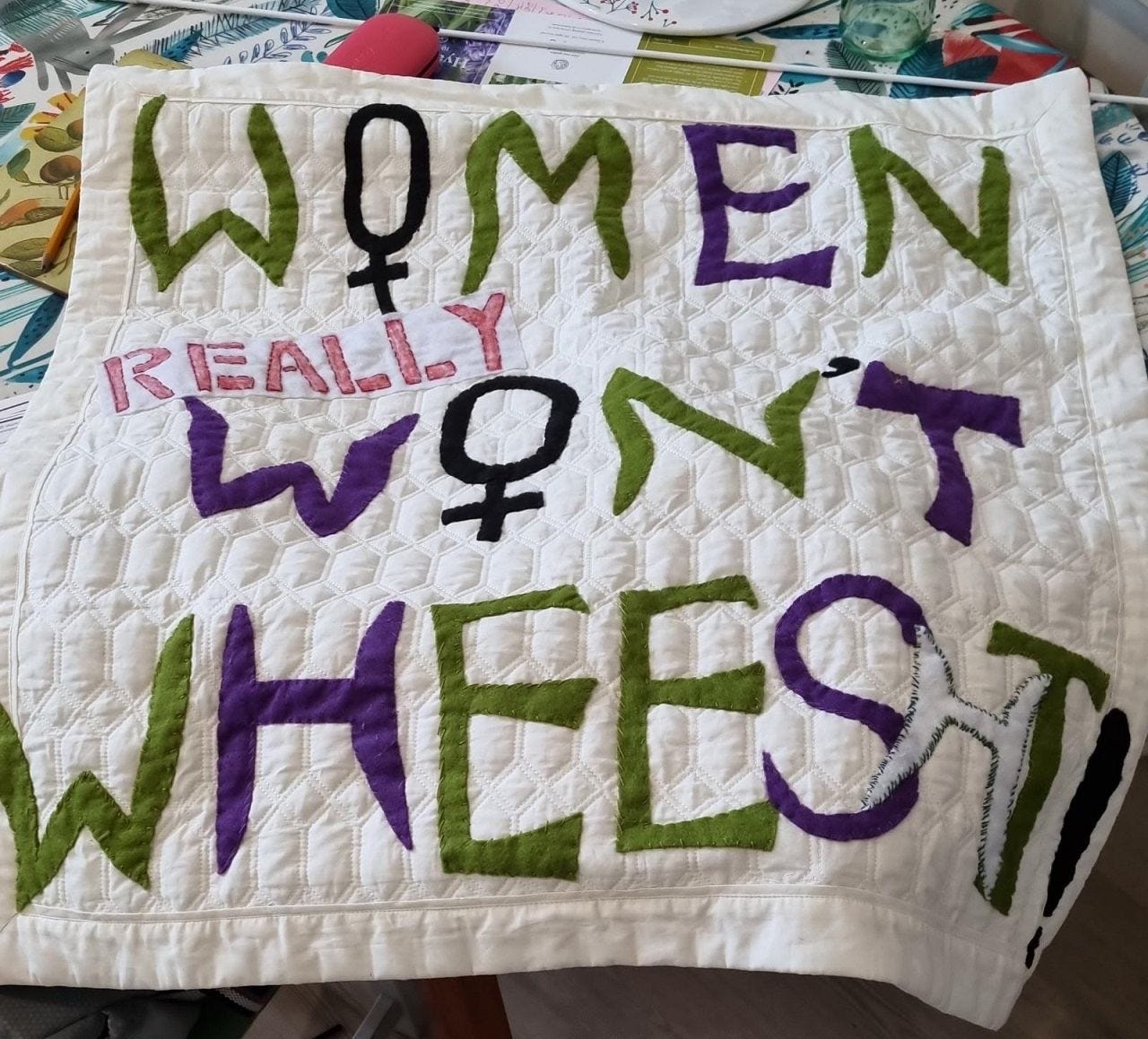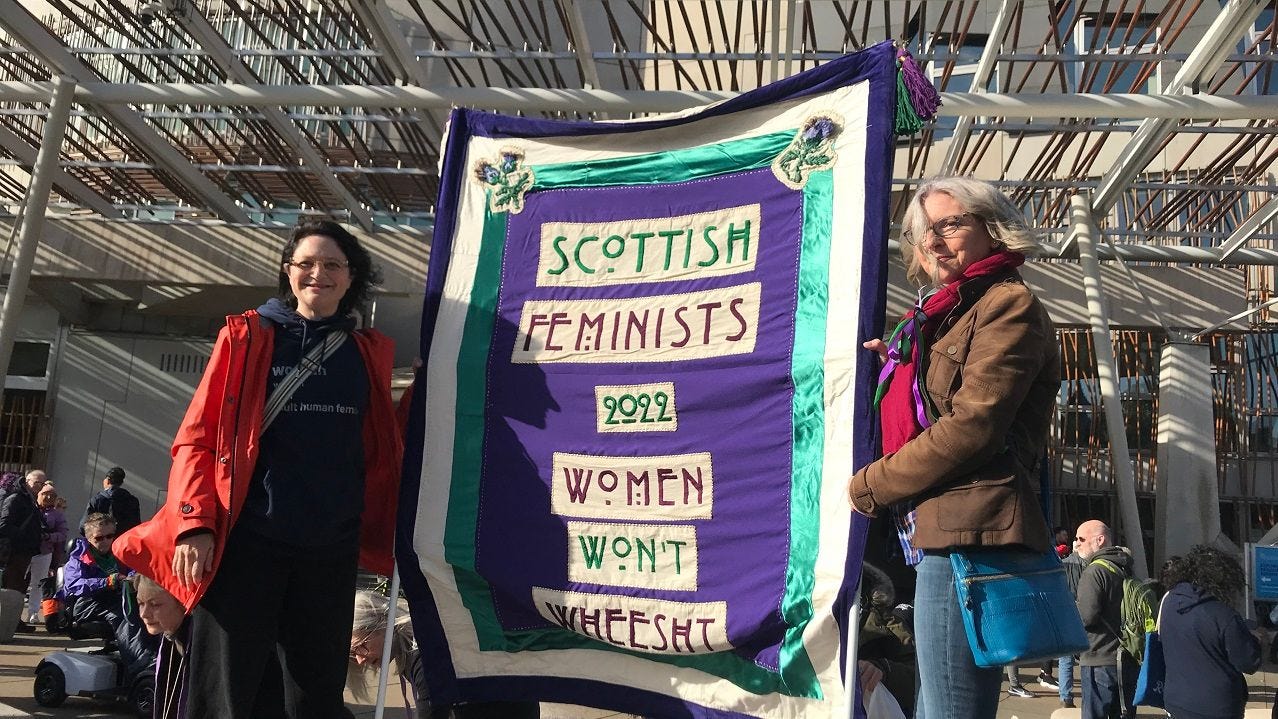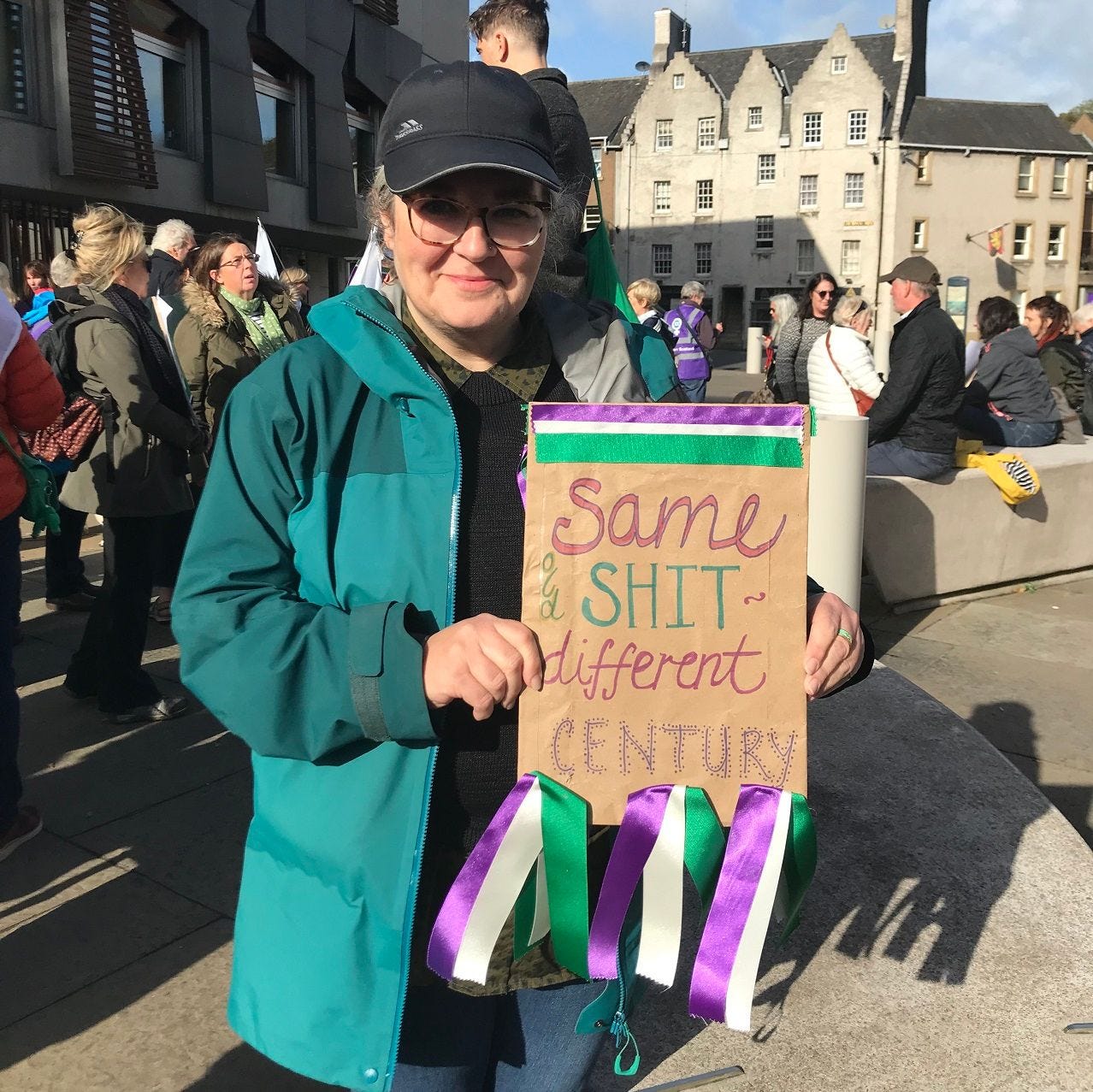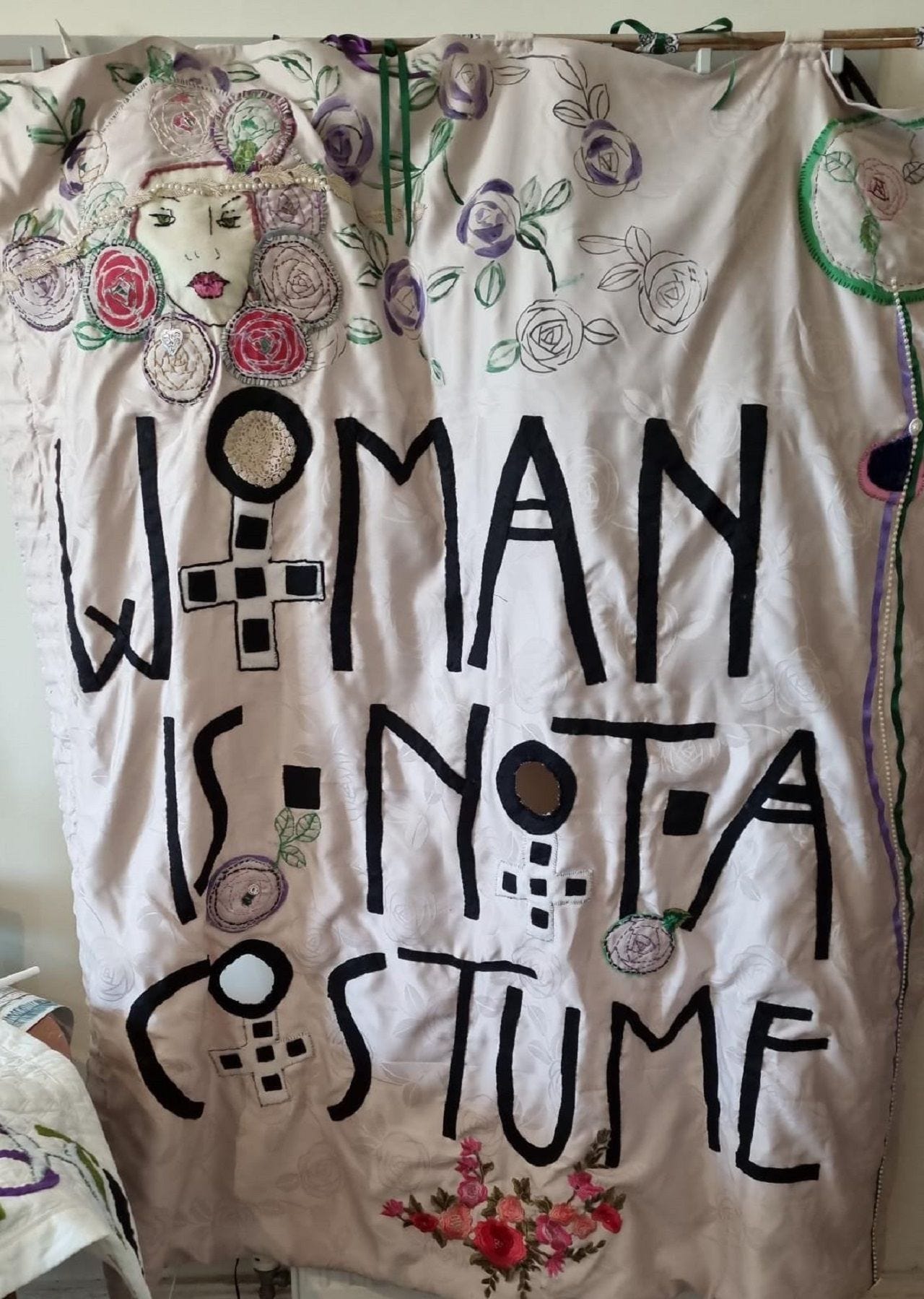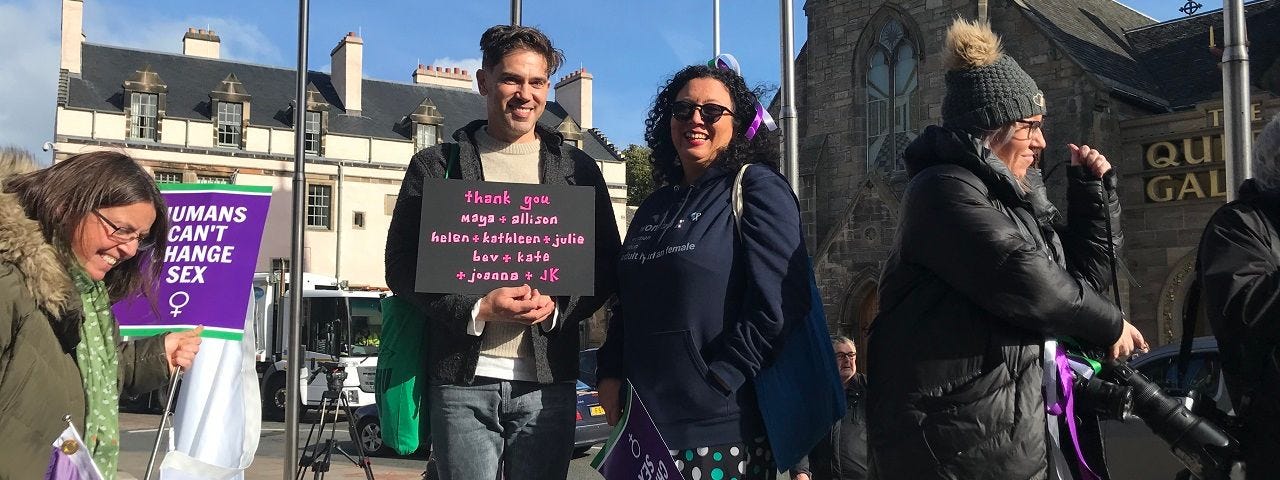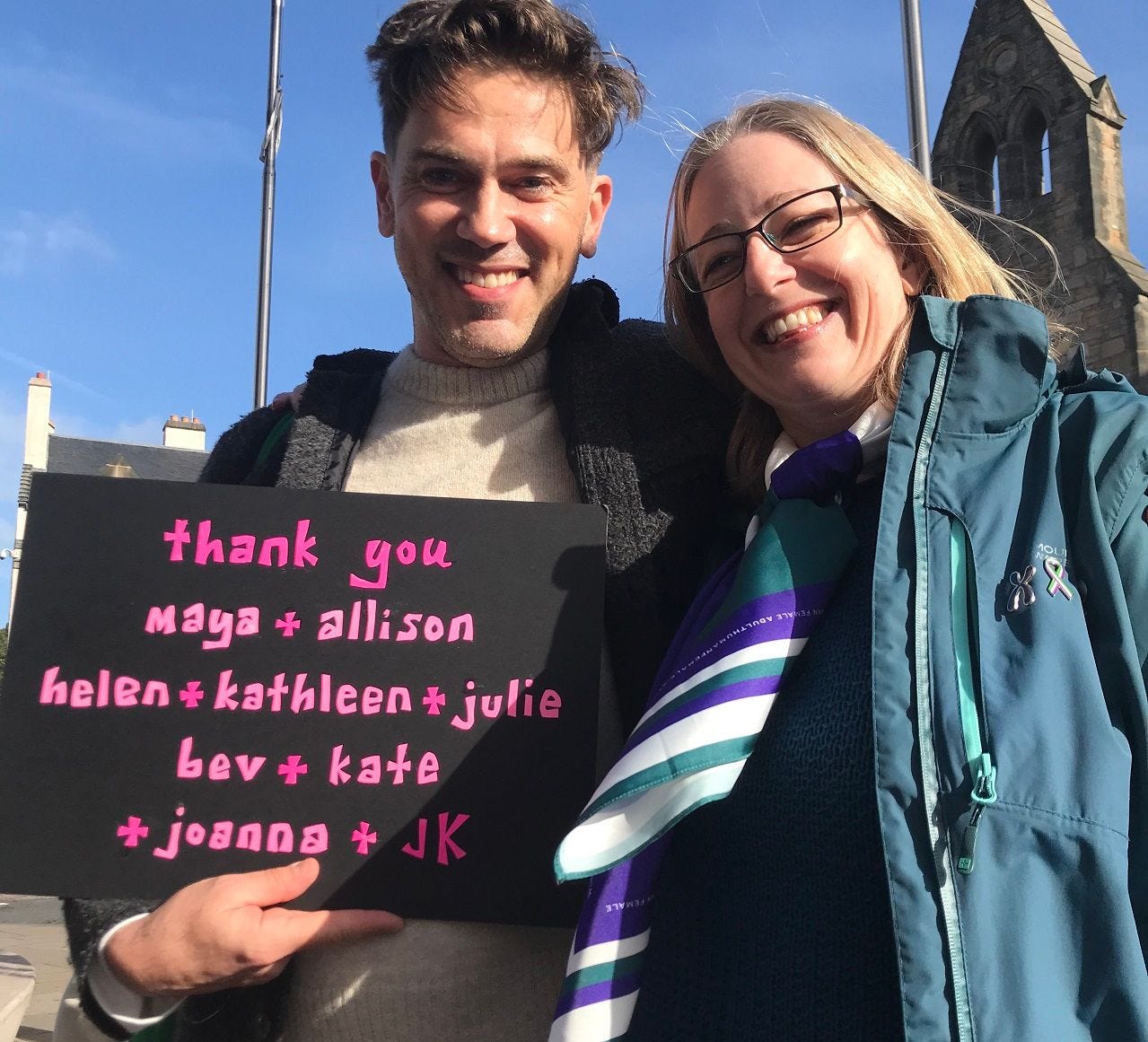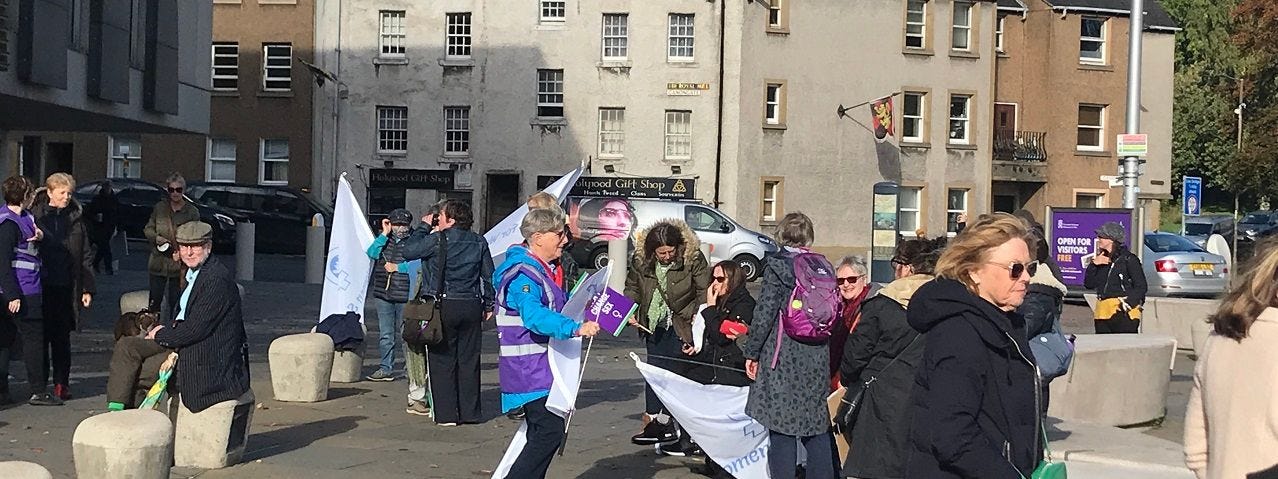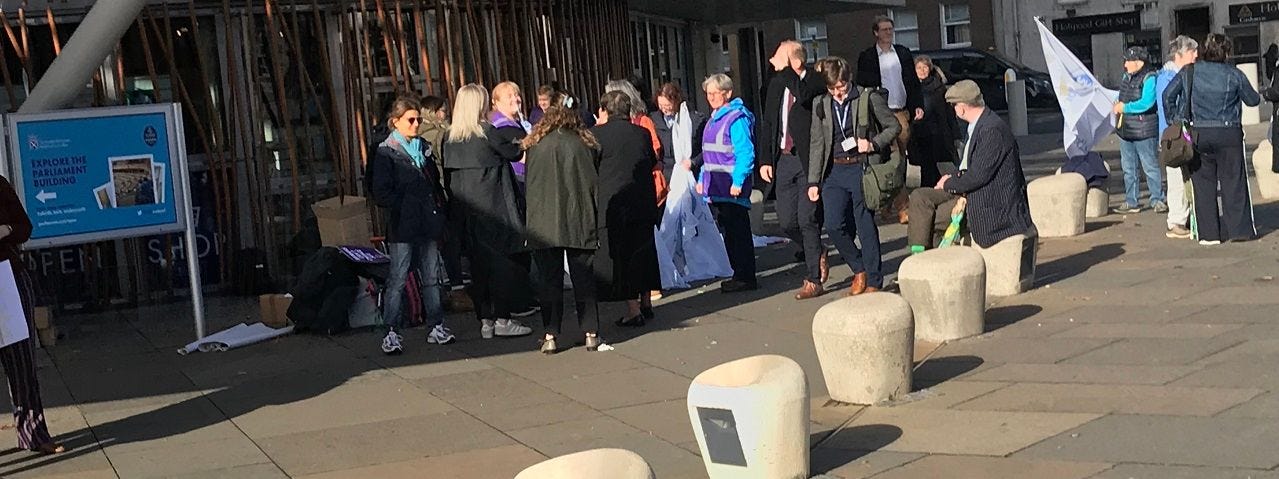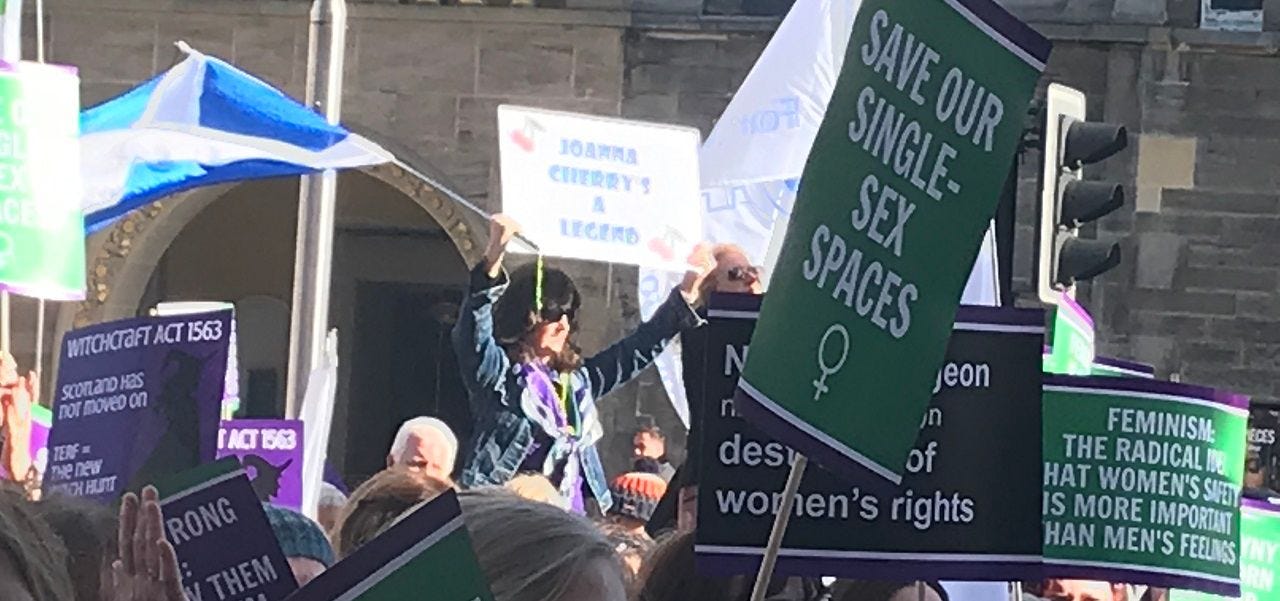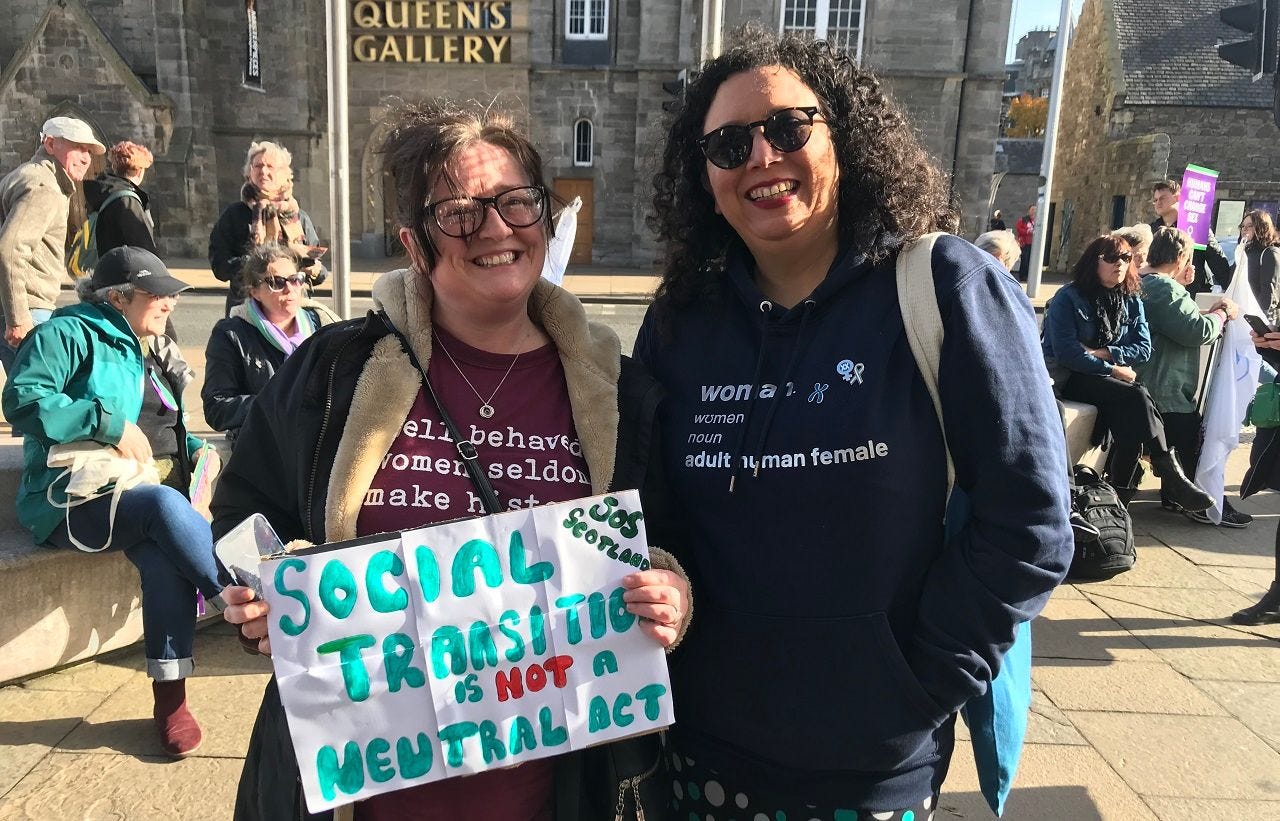Of drag queens and toddlers
Why does anyone think men dressed as garish, sexualised parodies of women are particularly suited to reading to children?
First, apologies for missing a week—my trip to Scotland for the protest outside Holyrood threw my schedule more than I expected. But it was well worth it. Scotland’s polarised, tribal politics, in which the choice between independence or union trumps all other issues, grants the Scottish Nationalist Party an unassailable position in Holyrood—and not coincidentally means Scotland is terribly governed, with high drug deaths, plus awful education and health care. So self-proclaimed “feminist to her fingertips” Nicola Sturgeon will be able to push her mad gender self-ID plans through, no matter that they are wildly unpopular with ordinary people. But at least protests like last week’s mean that when the problems become undeniable, she won’t be able to say “nobody warned us”.
If this newsletter was forwarded to you, you might like to sign up for free updates. I hope that in the future you might consider subscribing.
Onwards and upwards. The Great GC Schism of Late 2022 came between my asking on Twitter what people thought about Drag Queen Story Hour (DQSH), and my getting around to writing my own thoughts, informed by the many helpful responses I received. But I’m now Moving On, and if I can possibly help it will not be commenting further on events of the Past Three Weeks. Business as usual is very much resuming.
So, drag queens reading to toddlers in libraries and pupils in primary schools. Personally, I’m not keen. In fact I’m very much the opposite. I’m sure that most of the people who book these acts, and the parents who bring their children, mean no harm by it. But I think there’s no good reason to have blokes dressed as parodies of womanhood reading to small children—and there are plenty of bad ones.
Before I start, let’s get what is surely the biggest enabling factor out of the way: “Ru Paul’s Drag Race”. That put drag in the mainstream, and itself needs no more explanation than the hunger of television executives for new formats, especially those that allow for transformations and big reveals. I can’t tell you why people watch it—but then I’m no barometer of public taste, since I also dislike “Strictly Ballroom” and cookery shows. This is probably a good moment to admit that I also greatly dislike clowns and pantomime dames, and in general all exaggerated portrayals that are supposed to be funny or striking. I think they manage to be both tedious and terrifying at the same time, which is quite the feat.
I suppose it’s simple enough: there’s a large audience for seeing people made up and dressed up to look very different, even if every time it’s different in the same way. And if some adults enjoy watching men in adult venues telling dirty jokes while in the persona of…well, I don’t even know how to describe what they are pretending to be; certainly not actual women…, that’s no problem with me, even if personally I’d prefer to spend the evening cleaning toilets with a toothbrush.
My question is more specific: why would anyone think those men are particularly suited to reading to children? That’s what baffles me, and that’s why I asked for people’s thoughts. Thanks to all who responded on Twitter, or took the time to message me in other ways. What follows is informed by what you all said.
Most of those who responded to my tweet were also critical of DQSH, but a few weren’t. Some of those responses, generally rude and dismissive, suggested that I was an idiot for not being able to see that the aim is to encourage children’s imaginations and to teach them to have fun and play. One mocked me for questioning the scheme’s learning objectives, saying this was overly serious and point-missing on my part. But a school or library with a budget for kids’ events does have to think about what it is trying to achieve. To adults who answer: “why does it need to teach something? Why can’t it just be fun?” I’d say: “Fun for whom?” Adults shouldn’t be subordinating children’s needs and desires to their own.
The idea that a special programme is required to stimulate children’s imaginations is another example of the way, as childbearing becomes later and families become smaller and more atomised, many more people have become profoundly ignorant about children. (I wrote about this in a previous issue.) I suppose their chain of thought is something like: children like bright things, glitter and make-believe, so they’ll like drag queens. But children can see the beauty and adventure in anything—famously, even the box a present came in. They don’t need their imaginations stimulated by adults! They don’t need to be taught how to dress up or pretend!
Some critics added that I must be a homophobe seeking to insinuate that gay men have nefarious purposes for wanting to be near children. This is equally revealing of ignorance, this time of the fundamentals of child safeguarding. I don’t think that gay men are any more likely than other men to want to harm or predate on children; I think that this particular scheme raises multiple red flags, and am well aware that calling me a bigot for such concerns is the prime way to brush them off.
Anyone who does any training on child safeguarding will be warned that worries about children’s safety and well-being are likely to be responded to with claims that you are hateful, or that you must be allied with the far right since they too express such concerns. This has been happening for decades now, and I’m amazed anyone still has the cheek to try it.
Another way to shame people who prioritise safeguarding is to suggest that they are prudish or unsophisticated. This charge is levelled especially at middle-aged mothers—sometimes, sadly, by young women. I get it, I really do. We mothers are endlessly raining on parades—we’re the people who notice that what you’re doing is dangerous, and remind you that other people aren’t always what they seem. When it comes to kids, it’s our job not to give a toss if you think we’re a bore. But it is unpleasant for young women to think that they too will grow up to be killjoys.
None of this bothers me; I’ve been called worse. And if you aren’t willing to toughen up and ignore people who try to shame or embarrass or bully you out of seeking to keep children safe, then please stay away from positions where that is any part of your responsibility. If you remain silent for fear of what people might say, or you back down in the face of these attacks, you are indicating to predators everywhere that the door to your organisation is open. I guarantee you that, even if they’re not inside already, they will be soon.
So what precisely are the safeguarding risks I see in DQSH? The most obvious is that unsuitable people will get close to children while everyone is distracted by preening themselves about their “inclusivity”. As the seedy lawyer in the musical Chicago says, in a different context, “Give ’em the old hocus pocus/ Bead and feather ’em/ How can they see with sequins in their eyes?” When everyone’s oohing and aahing, and basking in the warm glow of their own inclusivity, their guard is down.
As the recent succession of scandals at child sex-change charity Mermaids has demonstrated, if your organisation works with children or other vulnerable people, then you put safeguarding either in first place or nowhere. Even if an organisation’s remit has nothing to do with sex—it’s a Boy Scouts group or a children’s sports team, say—it can still be used as a vehicle to gain access to victims. And if its very raison d’etre is to destabilise children’s sexed identities…well, your safeguarding has to be unimpeachable or you will end up recruiting totally unsuitable people.
I don’t know how Jacob Breslow, an apologist for paedophilia, became a trustee of Mermaids—whether the post was advertised or whether he was headhunted. But I presume whoever selected him was impressed by his vicious and legally ignorant article about Maya Forstater, published on the LSE Engenderings blog, which will have pandered to the recruiters’ own prejudices. I don’t know what specifically appealed about its most recent resignee, Darren Mew, either. But he certainly doesn’t give off “child safeguarding above all” vibes (this article from the Mail crops the picture of Mew dressed up as a sexy schoolgirl, lounging on a bed with his legs provocatively open. Incredible to think he worked for a charity for vulnerable children.)
Nor does Munroe Bergdorf, a transwoman who was briefly an “ambassador” for Mermaids a few years ago, despite encouraging kids to send him direct messages (this is a massive safeguarding red flag), and his praise for poor little “drag kid” Desmond is Amazing. You can read more about what happens when organisations like Mermaids and the NSPCC fail to prioritise safeguarding in an article by Maya on how raising safeguarding concerns has led to her being suspended from Twitter.
(Post-publication edit: in a remarkable illustration of precisely what she was saying, this article about transactivism and safeguarding red flags caused Maya to lose her Medium account.)
I don’t think most drag queens have a specific sexual interest in children, or want to abuse them. But I do think that drag acts are usually pretty smutty, and any drag queen worth his salt will have a social-media presence that no child should be Googling. I also think that DQSH offers anyone who gets a kick out of behaving sexually in front of children a golden opportunity. Arguably, I suppose, a man getting his jollies inside his head from performing suggestively in front of children doesn’t do all that much harm to them if they don’t know about it. I still think it’s disgusting, and don’t see why we should be facilitating it.
More broadly, the whole thing reeks of indoctrination. And it tarnishes a concept that queer theorists like to mock: the innocence of youth.
A common attempt at deflection is to say that drag queens are like pantomime dames, and nobody objects to kids going to pantomimes. This is an example of the sorites paradox, or the fallacy of the heap. If you take a single grain of sand away from a heap, it’s still a heap. And it remains one when you take away another grain of sand, and another—but at some point, you’re left with something that definitively isn’t a heap (eventually, you’re left with nothing). The fallacy is to say that categories with blurred boundaries cannot exist, rather than to accept that there are still plenty of things that fall unequivocally in one or the other.
So what if it’s impossible to draw a bright line between a drag queen and a pantomime dame? Both are men dressed as parodic women, and both can be quite smutty. But panto being okay doesn’t mean DQSH must be too. Dames are part of a larger entertainment, not the entire entertainment. They’re supporting actors, not stars. They’re not skimpily or provocatively dressed, and they parody older women, not street-walkers. They’re not right up in front of kids, and they’re not reading gender-identity propaganda.
Because DQSH isn’t only about the performers, it’s also about the reading material. This isn’t about random blokes, albeit oddly dressed, reading popular classics; it’s about men dressed as sexualised parodies of women reading books about how performance of and identification with gender stereotypes is what makes everyone boys or girls. The books the queens read are all along the same theme: “Red: A Crayon’s Story”; “The Hips on the Drag Queen Go Swish, Swish, Swish”; “Felix’s New Skirt”; “Julian is a Mermaid”.
This programme, in other words, is about smuggling gender-identity ideology into early years, under the guise of “diversity and inclusion”. A true diversity programme would mean getting people of all sorts to read to kids: butch lesbians, war veterans, refugees, nurses, firefighters… not just the tiny slice of humanity composed of drag queens.
From the point of view of the performers, the appeal of DQSH is obvious. Drag, if it makes you money at all, will do so mostly at night-time; fitting in a few day-time gigs is all upside. For mothers with babies, it’s something to be doing. I well remember how endless a day trying to keep a baby going can feel: the baby-massage classes; the long walks; the coffee mornings with other new mums. For a woman who, unlike me, enjoys drag shows, what could be better than an event marketed as educational that is also a reminder of the Before Times: the time when she had a life, a reboot of “my gay best friend”, a chance to feel cool again?
And if you want to throw in a bit of virtue-signalling while you’re at it—to place yourself on the non-mummy side of the divide between Cool Girls and Mimsy Mumsies—what better way than to use your child for it? Virtue-signals are always most effective when there’s something important involved.
A gay man who wrote to me suggested that a lot of people are still somewhat prejudiced against gay people, but feel ashamed of it. Instead of accepting that we’re all prisoners of our upbringing, and that what really matters is how they behave, not what they think or feel, they squash down their feelings. Someone like this will seek out opportunities to show that they are super-comfortable with even very in-your-face aspects of gay culture, all the while desperately trying to disavow their discomfort.
For venues, DQSH offers a chance to signal inclusivity in the loudest and easiest possible way: so-called “rainbow-washing”. And if everyone else is doing it, you don’t have much choice but to join the trend. As one person said: “If the neighbouring council is doing it you’d better do it too, or you’ll be called a Nazi.”
Several respondents suggested that part of the motivation for putting on DQSH was to annoy the right people—“owning the not-libs”, as one put it. Many of those working with children, including teachers, nowadays seem to believe that their most important job is to make sure children disavow their parents’ beliefs and values. DQSH is a way to flush out right-wing “difficult parents”, and to give them a hill to die on. You can provoke cultural conservatives to attack you, with plausible deniability—and then get to call them hateful. (“Why are you such a homophobe?”)
Another much-cited justification for DQST is that the queens are role models for gay kids. I don’t discount the possibility that the occasional little boy might look with wonder at a queen and think: that’s who I want to be! But there are also gay boys and men who find queens being the public face of gayness deeply irritating.
If you’re the sort of boy who suspects you may grow up to find your own sex attractive (and by the way, I’d question whether this realisation naturally dawns before puberty), you might well find the idea that a drag queen is an exemplar of what you will become embarrassing and off-putting. If doing drag is presented to your classmates as synonymous with being gay, I would think that is more likely to increase the risk of homophobic bullying rather than reduce it.
The idea that “drag” is part and parcel of “gay” is one element of a larger rift within “the LGBT community”—is your sexuality at least in part about your politics, presentation and identity, or solely about whom you want to go to bed with? See “Heterosexuality Without Women”, an extraordinary piece from 2019 in the LA Review of Books, which strongly suggests that American politician Pete Buttigieg’s marriage to a man does little or nothing to mark him as gay, against the countervailing force of his normie style.
DQSH, it seems to me, is less about teaching kids that it’s okay to grow up to love people of the same sex as you, and more about teaching them that “queerness”—subversion of norms of behaviour and appearance—is something to be aspired to.
By no means all gay adults agree with this. Many see their sexuality as simply a question of whom they’d like to sleep with and perhaps marry, rather than as an identity. They would probably say that, rather than having clownish, sexualised men visit their schools to read ideological stories, it would have more helpful if ordinary people—teachers, parents, postmen, nurses, whoever—had been free to mention their same-sex partners, hold those partners’ hands in public or put family pictures on their desks. But to the queer theorists, that agenda is “assimilationist”.
And what about the girls, both gay and straight? Isn’t it revealing that drag queens, who at best can only provide role models to proto-gay boys, not girls, are presented as role models to the entire “LGBT community”?”
As an adult you can decide whether you find drag an edgy and enjoyable subversion of gender-performance; children can’t. They have to sit there and endure it, no matter how much they may dislike it. Imagine being a young girl, of no matter which future sexuality, presented with what you may well experience as a hideous parody of the adulthood you are destined for. I’ve already said that I’ve always hated clowns. How much more I would have hated them if there had been any implication that what they were mimicking was what I was destined to be when I grew up.
Perhaps the single most striking thing about DQSH is that it’s a display of power. The power to be able to force something so inappropriate into a special place: a school, or a part of a library that has been set aside for parents, mostly mothers, with their infants. It intimidates me that people with an agenda I find inimical are so easily able to do this, and I think that intimidation is part of the purpose. Screw your sensibilities, DQSH says, and your queasy desire to shelter children from the sordid side of adulthood. You’re a dinosaur, and your children are ours to indoctrinate as we see fit.
You don’t have to be religious, romantic or naïve about childhood to regard it as a developmental period that should, as much as possible, be protected from the adult preoccupations of self-presentation, politics, money and sexuality. I’m not religious, but I was brought up Catholic and religious language comes naturally to me. When I see drag queens reading to toddlers on their mothers’ laps, I see sacrilege: a symbolic crime, like scrawling vulgar graffiti on a holy book.
If there is a practical agenda alongside this display of cultural hegemony, I think it’s to get children used to using female names and the words “she” and “woman” for strange-looking people dressed and made up as garish imitations of women, but who are obviously men. For anyone who thinks stated gender identity should trump sex, that is immensely useful. Get to children before they fully realise what makes people boys or girls, men or women, disrupt that emerging understanding—and everything will be so much easier later on.
If you were forwarded this edition of Joyce Activated and would like to subscribe, click below.
PS. And what about “drag kids” like Desmond is Amazing, mentioned above?
I don’t have a problem with little boys playing with makeup and heels—at home, without pictures, and certainly without pictures that are shared anywhere, not even a closed Facebook group. But articles like this about “drag kids”, from the New York Times in 2019, bring to my mind the expression, variously attributed to Richard Feynman or Carl Sagan, “so open-minded your brains fall out”. Here’s a more outraged—and accurate—take from the Spectator.
Poor little Desmond is Amazing, whose parents tour him around adult clubs to pose with seedy people and take tips for flouncing and pouting on a stage. What can they be thinking? And how can anyone connive in it, let alone cheer it along? Convicted paedophile Tom O’Carroll has written an article stating: “Desmond is Truly Amazing—and Hot!” I’m not linking to it, and I’m not quoting from it, but you can easily find it if you want.
Some years ago I tweeted an early article on drag kids, with an angry comment. To my astonishment, a couple of young women I knew and liked jumped in to tell me I was homophobic, and to ask rhetorically if I also condemned (girl-)child beauty queens. Absolutely! There’s time enough for a girl to drag up when she’s grown-up, if that’s what she wants to do.
But the people who engage in this particular form of whataboutery are ignoring how easy it is to condemn beauty pageants for little girls if your bugbears are the objectification of girls and women, and you hate conservative “flyover” America. The way these little boys are styled to look like smutty adult entertainers is much more disturbing, but that seems to pass these people by. I think that’s because, to some on the left, subverting norms is seen as such an important goal that they are blind to the damage such subversion causes to children.
They also ignore the fact that paedophiles are far more often interested in boys than in girls. The word “paedophile” here is specific. Girls are more likely to suffer sex abuse aged under 16 than boys are, but that is mostly girls who are aged 14 and 15, and the men are creeps and rapists, rather than erotically interested in pre-pubescent bodies. Paedophiles—people turned on by pre-pubescent children—mostly target boys.
All this has been very depressing to write about. So here are some pictures from Edinburgh last week (I’ve put much fewer pictures than usual in the main article, and all rather abstract because I don’t want to single out any particular drag queens, and certainly don’t want to draw any more attention to drag kids, whom I see as victims). The self-ID law Nicola Sturgeon is so determined to push through will be a disaster, of course. But the protest was heart-warming, and it was wonderful to meet so many indomitable women.



